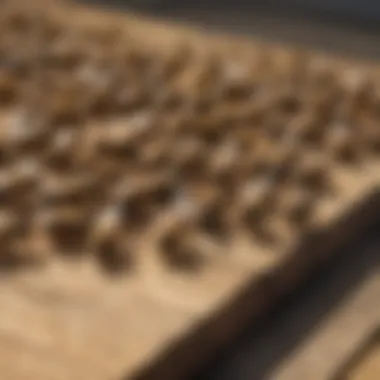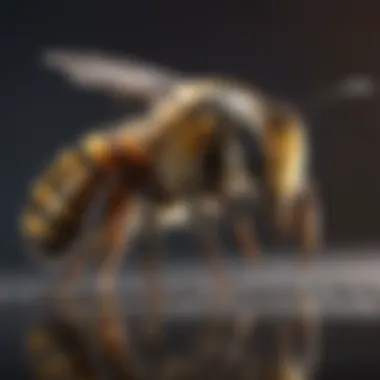Effective Strategies for Removing Bees Safely


Intro
Dealing with bees on your deck can be a frustrating experience for homeowners. Understanding the nature of these insects, as well as employing effective removal strategies, is essential. This article will guide you through the process, emphasizing not only removal but also safety and ecological considerations.
Understanding Pests
Definition of Pests
Pests are organisms that can cause harm to human interests. They often come into conflict with people due to their habits or behaviors. Bees, while considered pests in certain situations, play a crucial role in ecosystems as pollinators. Thus, it's important to approach the issue with a knowing mind.
Importance of Pest Identification
Identifying bee species is an important first step. Not all bees are the same; some are solitary, while others live in colonies. For example, honeybees, bumblebees, and carpenter bees each have distinct behaviors and ecological roles. Knowing the species can help determine the best approach for removal, especially since some may be protected by law. This understanding fosters respect for these insects, encouraging humane management practices.
Prevention Techniques
Home and Garden Preventative Measures
Ensuring that your deck remains bee-free often begins with preventive measures. Start with these strategies:
- Remove food sources: Keep leftover food or opened containers away.
- Seal entry points: Inspect your deck for spaces where bees can build nests.
- Maintain landscape: Trim overhanging branches and maintain shrubs that might attract bees.
Seasonal Prevention Tips
Knowing when bees are most active can help homeowners take timely action:
- Spring and summer: Bees are particularly active during these seasons. Plan regular deck cleanings.
- Fall: As bees begin to prepare for winter, they may search for sheltered places. Inspect your deck and close any openings.
Eco-Friendly Pest Control Solutions
Overview of Sustainable Practices
Using environmentally friendly methods can protect bees while resolving the issue:
- Physical barriers: Installing mesh screens on your deck can prevent bees from entering without harm.
- Natural repellents: Using essential oils like peppermint can deter bees without direct harm.
Natural Remedies and Their Effectiveness
Several natural remedies can be effective in discouraging bees:
- Cinnamon: Bees dislike cinnamon when placed around areas where they frequent.
- Vinegar or soap water: A mixture can help remove bee scents that attract others.
"The goal is to practice humane management, appreciating the role of bees in our environment while effectively addressing any issues that arise."
By understanding bees and utilizing these strategies, homeowners can maintain a safe and enjoyable outdoor environment.
Understanding Bees
Understanding bees is crucial when addressing their presence on your deck. It is important to know what type of bees you are dealing with, as this can influence your removal strategy. Additionally, understanding the ecological role that bees play provides context to why you should opt for humane removal strategies rather than extermination. By recognizing their benefits and how to coexist, homeowners can ensure a safer and more balanced environment.
Types of Bees Commonly Encountered
Identification of Honey Bees
Identifying honey bees is vital because they are often seen around homes. They are small, with a body length of about 1.5 to 2 inches. A key characteristic is their yellow and black striped body. Unlike some other species, honey bees live in large colonies in well-structured hives. Their presence is usually indicative of a nearby hive. This identification is beneficial for this article as honey bees are crucial pollinators and are protected in many areas. Therefore, realizing their importance helps dictate a humane approach when dealing with them, as extermination can lead to ecological consequences.
Recognition of Bumblebees
Bumblebees are generally larger than honey bees and have a more rounded body shape. They often have a fuzzy appearance due to their hairy bodies. The recognition of bumblebees is essential because they typically nest in the ground and can be less aggressive than honey bees. Highlighting their key characteristic of nesting behavior informs homeowners to seek natural removal options. Their role in pollination also makes them a beneficial species to protect.


Distinguishing Carpenter Bees
Distinguishing carpenter bees can be tricky as they resemble bumblebees. However, a noticeable feature is their shiny, hairless abdomen. Carpenter bees are notorious for boring holes into wood, making them a concern for homeowners. Knowledge of this unique attribute aids in understanding the damage they can cause. Awareness of their nesting habits enables more informed decisions regarding removal, possibly involving relocation rather than extermination.
Ecological Role of Bees
Pollination Importance
Pollination is a fundamental ecological process that bees significantly contribute to. They assist flowers in reproducing by transferring pollen from one blossom to another, facilitating the growth of fruits and seeds. The impact of this process cannot be overstated, as it directly affects food production and biodiversity. Given their importance in agriculture, protecting pollinators like bees is beneficial not just environmentally but also economically for local communities.
Bee Conservation Issues
Bee conservation issues are increasingly urgent due to habitat loss, pesticide use, and climate change. Understanding these issues enables homeowners to implement practices that protect local bee populations. Recognizing the decline in bee numbers is not only beneficial for the environment but also crucial for sustaining agriculture. By being informed, individuals can adjust their gardening practices or landscape choices to better support local ecosystems.
"Protecting bee populations is essential for the health of our environment and food supply."
Identifying Bee Infestations
Identifying bee infestations is a crucial aspect of managing bees around your dwelling. Being able to recognize the signs of their presence not only ensures your safety but also helps you to implement effective removal strategies. Awareness of bee activity can prevent painful stings and potential allergic reactions. Furthermore, understanding how to identify these infestations can aid in the development of preventive measures, protecting both your outdoor space and the bees themselves.
Signs of Bee Activity
Buzzing Sounds
Buzzing sounds serve as a prominent indicator of bee activity. This is a very distinct characteristic of bees that alerts homeowners to their presence. Often, the sound can be heard before any visual confirmation of bees or their nests occurs. Notably, the buzz of a bee can vary in intensity and pitch based on the size and type of bee, making it a unique auditory signal.
- Key Characteristic: Consistent buzzing often suggests nearby nests or foraging behavior.
- Contribution to Identifying Infestations: The sound helps create an early warning system, allowing you to take precautionary measures.
- Advantages: Relying on sounds is non-invasive. You don’t need to visually inspect every nook and cranny to detect them.
- Disadvantages: The presence of other insects may produce similar sounds, which can lead to confusion.
Visible Nesting Sites
Visible nesting sites are another pivotal aspect in recognizing bee infestations. Bees often construct their nests in sheltered areas, and these can often become quite apparent upon closer inspection. Being vigilant about these locations is essential in understanding the extent of the infestation you might be facing.
- Key Characteristic: Nests can vary in appearance and location depending on the species involved.
- Contribution to Identifying Infestations: Discovering nesting sites allows for direct assessment of the situation and influences effective removal approaches.
- Advantages: Easily observable nests bring clarity to your efforts in Bee management and offer insight into the severity of the situation.
- Disadvantages: Not all bee nests are easily visible. This limited visibility can delay identification and action if nests are hidden.
Differentiating Between Types of Activity
Solitary Bees vs. Social Bees
Differentiating between solitary bees and social bees is vital in effectively managing your bee population. Solitary bees, like mason bees, usually do not form large colonies and prefer nesting alone. In contrast, social bees like honey bees live in colonies and exhibit coordinated behaviors. Understanding these differences can help shape your response strategies.
- Key Characteristic: Their nesting habits and social structures vary significantly.
- Contribution to Identifying Infestations: Knowing which type of bee you are dealing with aids in determining how to proceed – whether to relocate or simply deter them.
- Advantages: This knowledge allows for more targeted and less harmful approaches during removal processes.
- Disadvantages: Misidentification may lead to ineffective strategies, resulting in continued bee presence.
Nest Formation Patterns
Nest formation patterns can also guide understanding bee activity. Analyzing how bees construct their nests provides insight into their behavior and the specific species present. These patterns can differ greatly between species, creating a framework for identifying infestations.
- Key Characteristic: Different species have unique nesting preferences, which can indicate their environmental needs.
- Contribution to Identifying Infestations: Recognizing these patterns allows homeowners to predict potential future infestations based on habitat suitability.
- Advantages: Helps create long-term strategies for management, preventing re-nesting in unwanted areas.
- Disadvantages: Some nesting patterns may closely resemble those of other insects, complicating identification to the untrained eye.
Safety Considerations
When dealing with bee removal from your deck, ensuring safety is of utmost importance. Bee stings can result in health risks that vary from mild discomfort to severe allergic reactions. Understanding these risks helps homeowners minimize danger while effectively managing bee presence. Precautions and protective measures add layers of safety, making the process less stressful for both humans and bees alike.
Risks of Bee Stings
Allergic Reactions
An allergic reaction to bee stings can be quite serious. For some individuals, a sting prompts an immune response that can escalate to anaphylaxis, a life-threatening condition. This overreaction involves swelling, difficulty in breathing, and a rapid drop in blood pressure.
Recognizing your allergy status is critical, as it informs how you should approach bee encounters. This section emphasizes the need for awareness around personal health history regarding bee stings. Understanding these allergic responses not only aids in safe removal but also encourages quick action if a sting occurs.
Precautions to Take


Taking proper precautions can significantly reduce the risk of bee stings. This involves several strategies; for example, avoiding floral patterns on clothing, as such designs may attract bees. Furthermore, it is crucial to remain calm when bees are nearby; erratic movements can provoke them.
By adhering to these practical guidelines, homeowners can mitigate risks effectively. Simple changes in behavior can replace potential encounters with peaceful coexistence. Recognizing the importance of these precautions is key to the overall management of bee populations.
Protective Measures
Wearing Appropriate Clothing
Wearing appropriate clothing is a sound strategy to prevent bee stings. Light-colored clothing is less attractive to bees, whereas dark colors might provoke them. Long sleeves and pants provide a physical barrier, reducing skin exposure.
Such measures make it more difficult for bees to sting, which is beneficial for ongoing deck use. Choosing suitable attire not only offers greater safety but can be an easy yet effective step in managing bee interactions.
Using Protective Gear
Using protective gear is essential for those closely involved in bee removal. Bee suits, gloves, and veils can protect against stings. This gear is specifically designed to offer significant protection. Their use demonstrates a proactive approach to safety while dealing with bees.
Investing in high-quality protective gear reduces health risks in a substantial way. It also instills confidence in homeowners addressing bee issues, creating a safer environment overall.
Key takeaway: Safety should always be prioritized in any bee removal effort, considering the presence of potential risks and planning appropriate protective measures.
Humane Removal Techniques
Humane removal techniques are essential for managing bee populations that may take residence on your deck. These methods prioritize the well-being of bees, recognizing their environmental significance while minimizing human interference. The primary benefit of humane removal is the preservation of local bee species, which play a critical role in pollination. Furthermore, compassionate strategies can avert unnecessary risks of bee stings, enhancing safety for homeowners and their families.
Natural Deterrents
Natural deterrents serve as effective and environmentally conscious strategies for discouraging bee activity. Understanding how to utilize these options correctly can contribute to the overall goal of removing bees from your deck while maintaining harmony with nature.
Using Essential Oils
Using essential oils is a recognized method for deterring bees naturally. Oils such as peppermint, spearmint, or citronella possess strong scents that are unappealing to bees. This characteristic makes essential oils a popular choice among homeowners seeking non-intrusive solutions. The unique feature of essential oils is their ability to repel bees without causing harm. This aspect contributes significantly to the objective of humane removal. However, it is essential to apply these oils properly, as excessive use may lead to an overwhelming scent that could attract other species instead of deterring bees.
Plant-Based Solutions
Plant-based solutions are another popular approach for managing bee presence on your deck. Certain plants, like marigolds, may deter bees due to their natural properties. Their key characteristic lies in their ability to coexist with surrounding flora while preventing uneasy encounters with bees. This method can be beneficial as it supports local ecosystems without causing distress. Nonetheless, proper consideration must be taken regarding the specific plants used, as some may also attract bees if not selected carefully.
Relocating Bee Nests
Relocating bee nests safely is a fundamental aspect of humane bee management. This technique focuses on preserving the bees while ensuring they are moved away from areas where they pose a risk to human activities. A key aspect of successful relocation lies in understanding bee behavior, enabling effective and stress-free movement of nests.
How to Safely Relocate Nests
How to safely relocate nests requires careful planning and execution. The process includes identifying the nest, preferably during early morning when bees are less active. Gently removing the nest and relocating it to an appropriate area away from your deck underscores the importance of sensitivity towards these pollinators. The unique feature of this method is that it can often be done without harming the bees or their young, allowing them to continue their essential role in the ecosystem. However, it requires a steady hand and a clear understanding of bee activity patterns to avoid confrontation.
Calling Professionals for Assistance
Calling professionals for assistance is an advisable option when facing significant bee infestations. Experts possess the necessary skills and equipment to relocate nests safely without distress to the bees or risk to humans. This aspect emphasizes the importance of experience in handling potentially dangerous situations. Relying on professionals can provide peace of mind to homeowners, ensuring that the process aligns with ethical and environmental standards. The unique feature of engaging such services is the knowledge and safety protocols experts follow, which ensure minimal risk during the removal process, although it might incur additional costs.
Preventive Measures
Preventive measures are crucial in managing bee presence effectively. By implementing strategies ahead of time, homeowners can minimize the risk of bee infestations. This not only enhances safety for individuals using the deck but also promotes a balanced ecosystem. Understanding the key elements involved in prevention can significantly reduce the need for removal later on.
Maintaining a Clean Deck
Maintaining cleanliness is vital for preventing bees from frequenting your deck. Regular cleaning practices significantly reduce attractants that draw bees. This approach involves routine tidying to remove residues or spills, particularly from sweet beverages or food remnants. The primary characteristic of this practice lies in its simplicity and minimal cost. A clean deck often is a less appealing environment for bees, thus lowering their chances of nesting nearby. However, one must be diligent, as neglecting this can easily reverse efforts made.
Regular Cleaning Practices
Regular cleaning practices involve daily or weekly upkeep to eliminate food sources and prevent potential nests. Sweeping the deck and wiping down surfaces are straightforward yet effective strategies. One major advantage of regular cleaning is that it does not require specialized tools or products; all that's needed are common household items. This accessibility makes it a popular choice. Yet, the significant time commitment can deter some homeowners. Thus, it is essential to have a systematic approach to upkeep.


Proper Food Storage
Proper food storage is an integral component of cleanliness. Storing food in sealed containers is critical to minimize odors that attract bees. This preventive measure reduces the likelihood of bees being drawn in by scents. Ensuring that food is not left exposed is a practical strategy that most homeowners can easily adopt. The characteristic of this technique is its direct impact on bee attraction.
However, storing food properly also means being consistent. A lapse in food storage protocols can render other prevention attempts ineffective.
Design Changes to Discourage Bees
Design adjustments around your deck create an environment less appealing to bees. Specific planting choices and landscaping considerations can make a significant impact. Adopting these strategies enhances not only the aesthetic value of your surroundings but also offers functional benefits in discouraging bee activity.
Plant Selection Around Deck
Selecting the right plants around the deck can greatly influence bee presence. Some plants naturally deter bees, while others attract them. Selecting low-attractant plants contributes to a less hospitable environment for bees. The primary feature, in this case, is how certain types of vegetation can serve as a barrier. This choice is beneficial, as it aids in maintaining a desirable aesthetic while minimizing bee attraction.
Notably, there's a balance needed; some plants provide benefits to the garden without inherently inviting bees. Homeowners must carefully select flora to align with both ecological preferences and personal tastes.
Landscaping Adjustments
Making strategic landscaping adjustments can further fend off bees. For instance, avoiding large open spaces with flowering plants minimizes bee habitat creation. Incorporating shrubbery or different ground covers can create an environment that is less favorable for nesting.
This characteristic of design can be powerful for prevention efforts. While it might require some initial investment, the long-term benefits of reduced bee encounters can be substantial.
Legal and Ethical Considerations
Understanding legal and ethical considerations is crucial when approaching the issue of bee removal. These factors guide homeowners in addressing bee infestations responsibly, ensuring that both safety and environmental integrity are preserved. Bees, particularly honey bees and bumblebees, play a significant role in our ecosystem. Thus, any removal strategy adopted should reflect an appreciation of their ecological importance, alongside compliance with local laws governing their management.
Local Regulations on Bee Removal
Understanding Local Laws
Comprehending local laws is paramount for homeowners dealing with bee removal. Different regions impose varying levels of protection for bees, especially for species recognized as endangered or threatened. By understanding these laws, homeowners can contribute to bee conservation while ensuring they act within legal boundaries. This knowledge is beneficial as it helps prevent penalties or fines that may arise from unlawful removal practices. Moreover, adhering to local regulations reflects responsible stewardship of natural resources.
Environmental Protection Guidelines
Environmental protection guidelines complement local laws by providing a framework for sustainable practices in bee management. These guidelines often emphasize the importance of protecting habitats and reducing harm to bee populations during removal. This combination of legal systems and guidelines promotes an ethical approach toward bee management. Following these recommendations can greatly benefit the ecosystem by maintaining bee populations, which are vital for pollination and biodiversity. Not adhering to these guidelines can lead to environmental degradation, affecting not just bees but other wildlife as well.
Ethical Treatment of Bees
Adopting an ethical approach to bee management is critical in the contemporary environmental landscape. As the public becomes more aware of the decline in bee populations and the ecological implications, the demand for humane treatment methods grows. The idea of treating bees ethically goes beyond mere compliance with legal statutes; it aligns with a broader commitment to respect all living organisms.
Importance of Non-lethal Methods
Implementing non-lethal methods for bee removal is increasingly seen as the best practice. These methods advocate for relocation rather than extermination, recognizing the crucial role bees play in our ecosystem. The adoption of non-lethal techniques not only respects bee life but also fosters community awareness about the necessity of these insects for agriculture and nature. While such methods may require more time and effort, they ultimately promote a sustainable approach to pest management.
Supporting Bee Conservation Efforts
Lastly, supporting bee conservation efforts is vital for sustainable bee management. Homeowners can contribute by engaging with local beekeeping communities or supporting organizations focused on preservation. Such involvement enhances the understanding of bee ecology and facilitates a shared responsibility for their conservation. Not only does this approach help maintain bee populations, but it also builds a connection between homeowners and their environment, fostering a community spirit centered around ecological health.
The End
In this article, the importance of understanding how to manage bee populations around your deck is paramount. Bees play an essential role in our ecosystems, particularly in pollination and maintaining biodiversity. Thus, while homeowners may face challenges with bee infestations, it is crucial to approach the issue respectfully and thoughtfully.
Summary of Key Points
To recap, we have explored several critical aspects:
- Understanding Bees: A basic overview of different types of bees and their ecological roles helps you appreciate their importance.
- Identifying Bee Infestations: Spotting signs of bee activity is crucial for early intervention.
- Safety Considerations: Recognizing the risks associated with bee stings and taking proper precautions ensures personal safety.
- Humane Removal Techniques: Implementing methods that do not harm the bees is both ethical and effective.
- Preventive Measures: Keeping your deck clean and making design changes can deter bees from making it their home.
- Legal and Ethical Considerations: Understanding local laws and guidelines reinforces the importance of responsible bee management.
These points underscore the balance between ensuring a safe environment for homeowners and fostering a protective stance toward these vital pollinators.
Encouragement for Safe Behaviors
As you navigate bee management, prioritize safety and the well-being of bees. Remember to:
- Always wear appropriate protective clothing when dealing with bees.
- Avoid aggressive actions that may provoke them. Bees typically only sting when threatened.
- Educate yourself further about bees and their roles in nature to enhance your knowledge and appreciation.
- Consider contacting local beekeepers or experts if you are uncertain about removal methods. They can offer valuable insights and assistance.
Taking these steps not only secures your comfort and safety but also contributes to the health of bee populations which is essential for our ecosystem.



